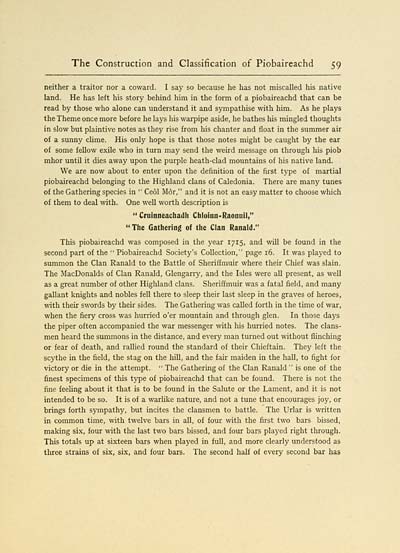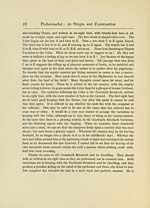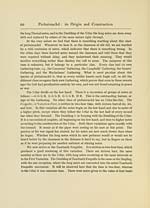Download files
Complete book:
Individual page:
Thumbnail gallery: Grid view | List view

The Construction and Classification of Piobaireachd 59
neither a traitor nor a coward. I say so because he has not miscalled his native
land. He has left his story behind him in the form of a piobaireachd that can be
read by those who alone can understand it and sympathise with him. As he plays
the Theme once more before he lays his warpipe aside, he bathes his mingled thoughts
in slow but plaintive notes as they rise from his chanter and float in the summer air
of a sunny clime. His only hope is that those notes might be caught by the ear
of some fellow exile who in turn may send the weird message on through his piob
mhor until it dies away upon the purple heath-clad mountains of his native land.
We are now about to enter upon the definition of the first type of martial
piobaireachd belonging to the Highland clans of Caledonia. There are many tunes
of the Gathering species in " Ceol Mor," and it is not an easy matter to choose which
of them to deal with. One well worth description is
" Cruinneachadh Chloinn-Raonuil,"
" The Gathering of the Clan Ranald."
This piobaireachd was composed in the year 1715, and will be found in the
second part of the " Piobaireachd Society's Collection," page 16. It was played to
summon the Clan Ranald to the Battle of Sheriffmuir where their Chief was slain.
The JIacDonalds of Clan Ranald, Glengarry, and the Isles were all present, as well
as a great number of other Highland clans. Sheriffmuir was a fatal field, and many
gallant knights and nobles fell there to sleep their last sleep in the graves of heroes,
with their swords by their sides. The Gathering was called forth in the time of war,
when the fiery cross was hurried o'er mountain and through glen. In those days
the piper often accompanied the war messenger with his hurried notes. The clans-
men heard the summons in the distance, and every man turned out without flinching
or fear of death, and rallied round the standard of their Chieftain. They left the
scythe in the field, the stag on the hill, and the fair maiden in the hall, to fight for
victory or die in the attempt. " The Gathering of the Clan Ranald " is one of the
finest specimens of this type of piobaireachd that can be found. There is not the
fine feehng about it that is to be found in the Salute or the Lament, and it is not
intended to be so. It is of a warhke nature, and not a tune that encourages joy, or
brings forth sympathy, but incites the clansmen to battle. The Urlar is written
in common time, with twelve bars in all, of four with the first two bars bissed,
making six, four with the last two bars bissed, and four bars played right through.
This totals up at sixteen bars when played in full, and more clearly understood as
three strains of six, six, and four bars. The second half of every second bar has
neither a traitor nor a coward. I say so because he has not miscalled his native
land. He has left his story behind him in the form of a piobaireachd that can be
read by those who alone can understand it and sympathise with him. As he plays
the Theme once more before he lays his warpipe aside, he bathes his mingled thoughts
in slow but plaintive notes as they rise from his chanter and float in the summer air
of a sunny clime. His only hope is that those notes might be caught by the ear
of some fellow exile who in turn may send the weird message on through his piob
mhor until it dies away upon the purple heath-clad mountains of his native land.
We are now about to enter upon the definition of the first type of martial
piobaireachd belonging to the Highland clans of Caledonia. There are many tunes
of the Gathering species in " Ceol Mor," and it is not an easy matter to choose which
of them to deal with. One well worth description is
" Cruinneachadh Chloinn-Raonuil,"
" The Gathering of the Clan Ranald."
This piobaireachd was composed in the year 1715, and will be found in the
second part of the " Piobaireachd Society's Collection," page 16. It was played to
summon the Clan Ranald to the Battle of Sheriffmuir where their Chief was slain.
The JIacDonalds of Clan Ranald, Glengarry, and the Isles were all present, as well
as a great number of other Highland clans. Sheriffmuir was a fatal field, and many
gallant knights and nobles fell there to sleep their last sleep in the graves of heroes,
with their swords by their sides. The Gathering was called forth in the time of war,
when the fiery cross was hurried o'er mountain and through glen. In those days
the piper often accompanied the war messenger with his hurried notes. The clans-
men heard the summons in the distance, and every man turned out without flinching
or fear of death, and rallied round the standard of their Chieftain. They left the
scythe in the field, the stag on the hill, and the fair maiden in the hall, to fight for
victory or die in the attempt. " The Gathering of the Clan Ranald " is one of the
finest specimens of this type of piobaireachd that can be found. There is not the
fine feehng about it that is to be found in the Salute or the Lament, and it is not
intended to be so. It is of a warhke nature, and not a tune that encourages joy, or
brings forth sympathy, but incites the clansmen to battle. The Urlar is written
in common time, with twelve bars in all, of four with the first two bars bissed,
making six, four with the last two bars bissed, and four bars played right through.
This totals up at sixteen bars when played in full, and more clearly understood as
three strains of six, six, and four bars. The second half of every second bar has
Set display mode to: Large image | Transcription
Images and transcriptions on this page, including medium image downloads, may be used under the Creative Commons Attribution 4.0 International Licence unless otherwise stated. ![]()
| Early Gaelic Book Collections > Hew Morrison Collection > Piobaireachd > (65) |
|---|
| Permanent URL | https://digital.nls.uk/81164697 |
|---|
| Description | A selection of items from a collection of 320 volumes and 30 pamphlets of literary and religious works in Scottish Gaelic. From the personal library of Hew Morrison, the first City Librarian of Edinburgh. |
|---|
| Description | Selected items from five 'Special and Named Printed Collections'. Includes books in Gaelic and other Celtic languages, works about the Gaels, their languages, literature, culture and history. |
|---|

